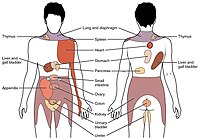
Photo from wikipedia
BackgroundIt is theorized that neck pain may cause reduced postural control due to the known physiological connection between the receptors in the cervical spine and the vestibular system. The purpose… Click to show full abstract
BackgroundIt is theorized that neck pain may cause reduced postural control due to the known physiological connection between the receptors in the cervical spine and the vestibular system. The purpose of this study was to examine whether the pressure pain threshold in the neck is associated with postural sway in patients with dizziness or neck pain.MethodsConsecutive patients with dizziness (n = 243) and neck pain (n = 129) were recruited from an otorhinolaryngological department and an outpatient spine clinic, respectively. All subjects underwent static posturography. Pressure pain thresholds were measured at four standardized points in the neck, and generalized pain was assessed using the American College of Rheumatology tender points. The relationship between postural sway and pressure pain threshold was analyzed by linear regression, and the covariates included age, sex, and generalized pain.ResultsIn the dizzy group, there was a small, inverse relationship between pressure pain thresholds and sway area with eyes closed, after adjusting for age, sex, and generalized pain (bare platform; lower neck, p = 0.002, R2 = 0.068; upper neck, p = 0.038, R2 = 0.047; foam rubber mat; lower neck, p = 0.014, R2 = 0.085). The same inverse relationship was found between pressure pain thresholds in the neck and the Romberg ratio on a bare platform after adjusting for age, sex and generalized pain (upper neck, p = 0.15, R2 = 0.053; lower neck, p = 0.002, R2 = 0.069). Neither of these relationships were present in the neck pain group.ConclusionOur findings indicate that the pressure pain threshold in the neck is associated with postural sway in patients suffering from dizziness after adjusting for age, sex, and generalized pain, but only with closed eyes. The association was small and should be interpreted with caution.Trial registrationTrial registration: Clinicaltrial.gov NCT03531619. Retrospectively registered 22 May 2018.
Journal Title: BMC Musculoskeletal Disorders
Year Published: 2019
Link to full text (if available)
Share on Social Media: Sign Up to like & get
recommendations!